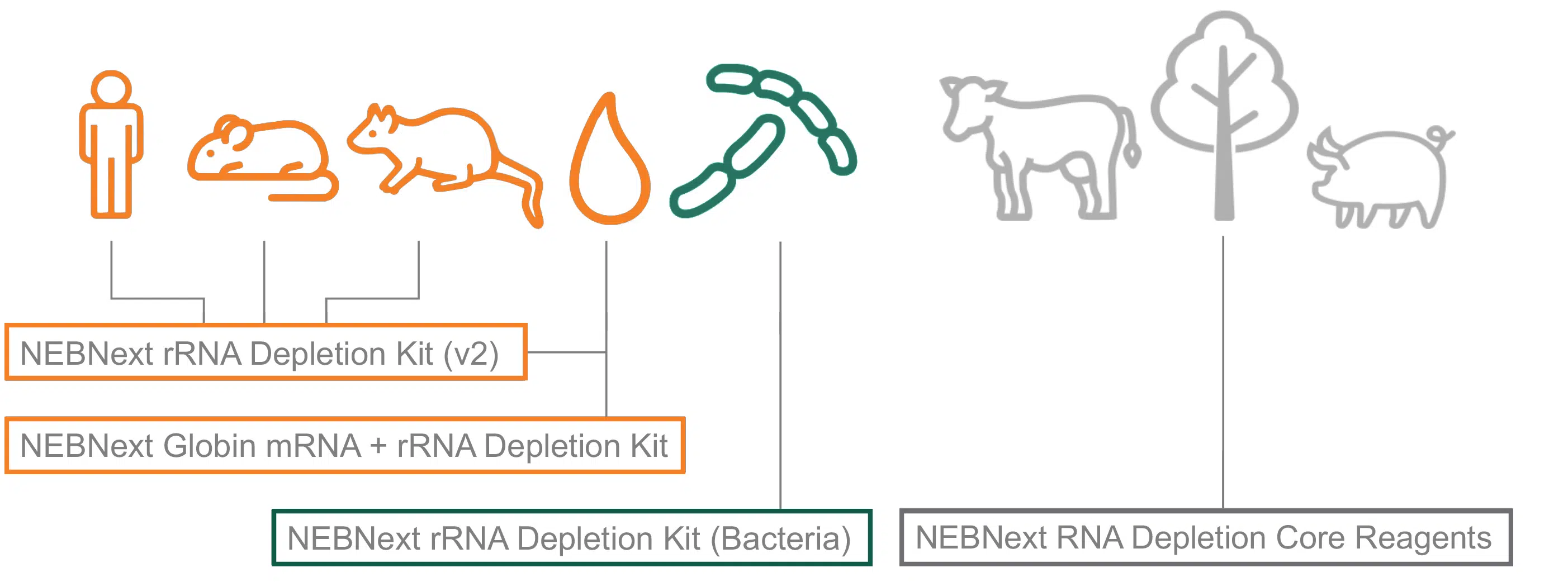Does NEBNext rRNA Depletion Kit Work for Your Species? A Comprehensive Guide
rRNA depletion is a critical step in RNA-seq workflows, especially for non-model organisms where ribosomal RNA (rRNA) can dominate 90% of total RNA. The NEBNext rRNA Depletion Kit (Human/Mouse/Rat) is widely used, but can it effectively deplete rRNA in other species? This article explores cross-species compatibility, success stories, limitations, and alternatives for RNase H-based rRNA depletion.
How the NEBNext rRNA Depletion Kit Works
The NEBNext rRNA Depletion Kit v2 (E7400) uses DNA probes designed to hybridize with human, mouse, and rat rRNA sequences, followed by RNase H digestion to remove rRNA. The process involves:
- Probe Hybridization: DNA probes bind to 5S, 5.8S, 18S, 28S, mitochondrial 12S, and 16S rRNA.
- RNase H Digestion: The enzyme cleaves RNA-DNA hybrids, leaving mRNA and non-rRNA transcripts intact.
- Library Prep: The remaining RNA is converted into a sequencing library.
Key Factor for Cross-Species Use: The success of depletion depends on sequence homology between the target species’ rRNA and the kit’s probes.
Which Species Are Compatible with NEBNext rRNA Depletion?
1. Species with Reported Success
- Canine: Used successfully in a 2020 study.
- Non-Human Primates (NHP): High probe homology (~95%) ensures strong depletion.
- Zebrafish: Mixed results—some users report good depletion, others see inefficiency.
- C. elegans: Works moderately due to partial sequence conservation.
- Drosophila: Requires custom probes (additional sequences improve depletion).
2. Species with Limited or No Success
- Avian (Birds): Poor depletion due to low rRNA sequence similarity.
- Bovine: Unconfirmed—some labs report partial success.
- Insects (e.g., Bees, Beetles): Generally ineffective without custom probes.
How to Check if NEBNext Will Work for Your Species
Option 1: Test with Shallow Sequencing
- Request a free NEBNext sample (via NEBNext Sample Request Form).
- Prepare an RNA-seq library.
- Run low-coverage sequencing to assess rRNA depletion efficiency.
Option 2: Analyze rRNA Sequence Homology
- Extract cytoplasmic (5S, 5.8S, 18S, 28S) and mitochondrial (12S, 16S) rRNA sequences from RNACentral.
- Submit FASTA files to NEB Technical Support (ask for Gillian) for homology analysis.
- If >70% homology, the kit may work.
Improving Depletion Efficiency for Non-Model Species
1. Combine NEBNext with Custom Probes
- Example: Drosophila researchers added species-specific probes to enhance depletion.
- Use NEB’s Custom Probe Design Tool for optimization.
2. Pre-Depletion rRNA Reduction Methods
- Poly-A Selection: If mRNA is polyadenylated (not ideal for non-polyA RNA).
- Oligo-dT Beads: Reduces rRNA but may lose non-coding RNAs.
3. Alternative rRNA Depletion Kits
- Ribo-Zero (Illumina): Broader species coverage but discontinued.
- Zymo-Seq RiboFree: Works for some non-mammalian species.
Case Studies: Real-World Applications
1. Canine RNA-seq (NEBNext v1)
- Result: >90% rRNA depletion achieved.
- Key Insight: High homology in 18S and 28S rRNA regions.
2. Zebrafish (Mixed Results)
- Successful Lab: Used overnight hybridization for better probe binding.
- Failed Lab: Found low 12S/16S homology led to poor mitochondrial rRNA depletion.
3. Drosophila (Custom Probes + NEBNext)
- Solution: Added 20 extra probes targeting insect-specific rRNA regions.
- Outcome: 85% rRNA removal, compared to 50% with NEBNext alone.
When to Avoid NEBNext rRNA Depletion
- Highly Divergent Species (e.g., plants, fungi, reptiles).
- Low Budget for Optimization: Custom probes add cost.
- Critical Need for Full Transcriptome: If rRNA depletion fails, consider poly-A selection.
Conclusion: Should You Use NEBNext for Your Species?
The NEBNext rRNA Depletion Kit can work beyond human, mouse, and rat—if your species has high rRNA sequence conservation. For canines, primates, and some invertebrates, it’s a viable option. For birds, insects, or highly divergent species, consider custom probes or alternative kits.
Next Steps:
- ✅ Check rRNA homology via NEB support.
- ✅ Test with shallow sequencing before full-scale experiments.
- ✅ Combine with custom probes if depletion is weak.
By following these strategies, you can maximize rRNA depletion efficiency and ensure high-quality RNA-seq data—even for non-model organisms.

